Related Research Articles
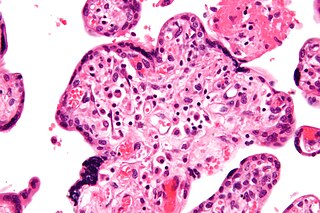
Intrauterine growth restriction (IUGR), or fetal growth restriction, refers to poor growth of a fetus while in the womb during pregnancy. IUGR is defined by clinical features of malnutrition and evidence of reduced growth regardless of an infant's birth weight percentile. The causes of IUGR are broad and may involve maternal, fetal, or placental complications.
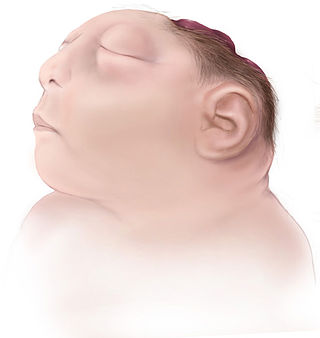
Anencephaly is the absence of a major portion of the brain, skull, and scalp that occurs during embryonic development. It is a cephalic disorder that results from a neural tube defect that occurs when the rostral (head) end of the neural tube fails to close, usually between the 23rd and 26th day following conception. Strictly speaking, the Greek term translates as "without a brain", but it is accepted that children born with this disorder usually only lack a telencephalon, the largest part of the brain consisting mainly of the cerebral hemispheres, including the neocortex, which is responsible for cognition. The remaining structure is usually covered only by a thin layer of membrane—skin, bone, meninges, etc., are all lacking. With very few exceptions, infants with this disorder do not survive longer than a few hours or days after birth.
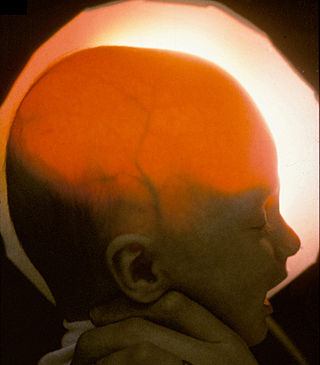
Hydranencephaly is a condition in which the brain's cerebral hemispheres are absent to a great degree and the remaining cranial cavity is filled with cerebrospinal fluid. "Cephalic" is the scientific term for "head" or "head end of body".
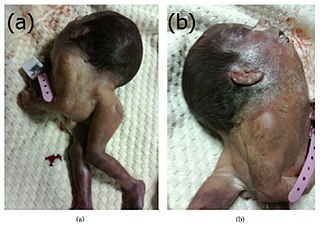
Iniencephaly is a rare type of cephalic disorder characterised by three common characteristics: a defect to the occipital bone, spina bifida of the cervical vertebrae and retroflexion of the head on the cervical spine. Stillbirth is the most common outcome, with a few rare examples of live birth, after which death invariably occurs within a short time.

A birth defect, also known as a congenital disorder, is an abnormal condition that is present at birth regardless of its cause. Birth defects may result in disabilities that may be physical, intellectual, or developmental. The disabilities can range from mild to severe. Birth defects are divided into two main types: structural disorders in which problems are seen with the shape of a body part and functional disorders in which problems exist with how a body part works. Functional disorders include metabolic and degenerative disorders. Some birth defects include both structural and functional disorders.
Late termination of pregnancy, also referred to as third trimester abortion, describes the termination of pregnancy by induced abortion during a late stage of gestation. In this context, late is not precisely defined, and different medical publications use varying gestational age thresholds. As of 2015 in the United States, more than 90% of abortions occur before the 13th week, 1.3% of abortions in the United States took place after the 21st week, and less than 1% occur after 24 weeks.

Prenatal testing is a tool that can be used to detect some of these abnormalities at various stages prior to birth. Prenatal testing consists of prenatal screening and prenatal diagnosis, which are aspects of prenatal care that focus on detecting problems with the pregnancy as early as possible. These may be anatomic and physiologic problems with the health of the zygote, embryo, or fetus, either before gestation even starts or as early in gestation as practicable. Screening can detect problems such as neural tube defects, chromosome abnormalities, and gene mutations that would lead to genetic disorders and birth defects, such as spina bifida, cleft palate, Down syndrome, Tay–Sachs disease, sickle cell anemia, thalassemia, cystic fibrosis, muscular dystrophy, and fragile X syndrome. Some tests are designed to discover problems which primarily affect the health of the mother, such as PAPP-A to detect pre-eclampsia or glucose tolerance tests to diagnose gestational diabetes. Screening can also detect anatomical defects such as hydrocephalus, anencephaly, heart defects, and amniotic band syndrome.

Polyhydramnios is a medical condition describing an excess of amniotic fluid in the amniotic sac. It is seen in about 1% of pregnancies. It is typically diagnosed when the amniotic fluid index (AFI) is greater than 24 cm. There are two clinical varieties of polyhydramnios: chronic polyhydramnios where excess amniotic fluid accumulates gradually, and acute polyhydramnios where excess amniotic fluid collects rapidly.
Potter sequence is the atypical physical appearance of a baby due to oligohydramnios experienced when in the uterus. It includes clubbed feet, pulmonary hypoplasia and cranial anomalies related to the oligohydramnios. Oligohydramnios is the decrease in amniotic fluid volume sufficient to cause deformations in morphogenesis of the baby.
Fetal viability is the ability of a human fetus to survive outside the uterus. Medical viability is generally considered to be between 23 and 24 weeks gestational age. Viability depends upon factors such as birth weight, gestational age, and the availability of advanced medical care. In low-income countries, half of newborns born at or below 32 weeks gestational age died due to a lack of medical access; in high-income countries, the vast majority of newborns born above 24 weeks gestational age survive.
Prenatal development includes the development of the embryo and of the fetus during a viviparous animal's gestation. Prenatal development starts with fertilization, in the germinal stage of embryonic development, and continues in fetal development until birth.
Neurodevelopmental disorders are a group of neurological disorders that affect the development of the nervous system, leading to abnormal brain function which may affect emotion, learning ability, self-control, and memory. The effects of neurodevelopmental disorders tend to last for a person's lifetime.
Abortion in Iran, as can be expected of many government policies, changed drastically between governments.
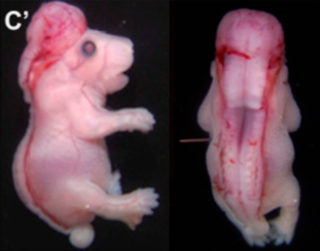
Rachischisis is a developmental birth defect involving the neural tube. This anomaly occurs in utero, when the posterior neuropore of the neural tube fails to close by the 27th intrauterine day. As a consequence the vertebrae overlying the open portion of the spinal cord do not fully form and remain unfused and open, leaving the spinal cord exposed. Patients with rachischisis have motor and sensory deficits, chronic infections, and disturbances in bladder function. This defect often occurs with anencephaly.

Pulmonary hypoplasia is incomplete development of the lungs, resulting in an abnormally low number or small size of bronchopulmonary segments or alveoli. A congenital malformation, it most often occurs secondary to other fetal abnormalities that interfere with normal development of the lungs. Primary (idiopathic) pulmonary hypoplasia is rare and usually not associated with other maternal or fetal abnormalities.
Abortion in Greece has been fully legalized since 1986, when Law 1609/1986 was passed effective from 3 July 1986. Partial legalization of abortion in Greece was passed in Law 821 in 1978 that provided for the legal termination of a pregnancy, with no time limitation, in the event of a threat to the health or life of the woman. This law also allowed for termination up to the 12th week of pregnancy due to psychiatric indications and to the 20th week due to fetal pathology. Following the passage of the 1986 law, abortions can be performed on-demand in hospitals for women whose pregnancies have not exceeded 12 weeks. In the case of rape or incest, an abortion can occur as late as 19 weeks, and as late as 24 weeks in the case of fetal abnormalities. In case of inevitable risk to the life of the pregnant woman or a risk of serious and continuous damage to her physical or mental health, termination of pregnancy is legal any time before birth. Girls under the age of 18 must get written permission from a parent or guardian before being allowed an abortion.
A pre-existing disease in pregnancy is a disease that is not directly caused by the pregnancy, in contrast to various complications of pregnancy, but which may become worse or be a potential risk to the pregnancy. A major component of this risk can result from necessary use of drugs in pregnancy to manage the disease.
A neonatal seizure is a seizure in a baby younger than age 4-weeks that is identifiable by an electrical recording of the brain. It is an occurrence of abnormal, paroxysmal, and persistent ictal rhythm with an amplitude of 2 microvolts in the electroencephalogram,. These may be manifested in form of stiffening or jerking of limbs or trunk. Sometimes random eye movements, cycling movements of legs, tonic eyeball movements, and lip-smacking movements may be observed. Alteration in heart rate, blood pressure, respiration, salivation, pupillary dilation, and other associated paroxysmal changes in the autonomic nervous system of infants may be caused due to these seizures. Often these changes are observed along with the observance of other clinical symptoms. A neonatal seizure may or may not be epileptic. Some of them may be provoked. Most neonatal seizures are due to secondary causes. With hypoxic ischemic encephalopathy being the most common cause in full term infants and intraventricular hemorrhage as the most common cause in preterm infants.
A termination for medical reasons (TFMR) is an induced abortion motivated by medical indications involving the fetus or mother. In most countries, health risks are the only basis for obtaining a legal abortion. Prenatal screening can allow early diagnosis, and abortion if desired or necessary. Some medical organizations advocate the offer of diagnostic testing by chorionic villi sampling, and amniocentesis to all pregnant women, as a matter of course.

Alcohol use in pregnancy includes use of alcohol at any time during gestation, including the time before a mother-to-be is aware that she is pregnant. Alcohol use at some point during pregnancy is common and appears to be rising in prevalence in the United States.
References
- ↑ "Recognition of Life Extinct by Ambulance Clinicians" (PDF). warwick.ac.uk. October 2006.
- ↑ Hopson, Laura R.; Hirsh, Emily; Delgado, Joao; Domeier, Robert M.; McSwain, Norman E. Jr; Krohmer, Jon (January 2003). "Guidelines for Withholding or Termination of Resuscitation in Prehospital Traumatic Cardiopulmonary Arrest: Joint Position Statement of the National Association of EMS Physicians and the American College of Surgeons Committee on Trauma". Journal of the American College of Surgeons. 196 (1): 106–112. doi:10.1016/S1072-7515(02)01668-X. ISSN 1879-1190. PMID 12517561.
- ↑ Wilkinson, Dominic; de Crespigny, Lachlan; Xafis, Vicki (October 2014). "Ethical language and decision-making for prenatally diagnosed lethal malformations". Seminars in Fetal & Neonatal Medicine. 19 (5): 306–311. doi:10.1016/j.siny.2014.08.007. ISSN 1744-165X. PMC 4339700 . PMID 25200733.
- ↑ Costa, Lúcia de Lourdes Ferreira da; Hardy, Ellen; Osis, Maria José Duarte; Faúndes, Anibal (2005). "Termination of Pregnancy for Fetal Abnormality Incompatible with Life: Women's Experiences in Brazil". Reproductive Health Matters. 13 (26): 139–146. doi:10.1016/S0968-8080(05)26198-0. ISSN 0968-8080. JSTOR 3776485. PMID 16291495. S2CID 10782601.
- ↑ "Herrera Beutler's 'miracle baby' gets kidney". The Columbian. 2023-10-10. Retrieved 2023-10-14.
- ↑ "Survival of Rep. Herrera Beutler's child a celebrated case study". The Seattle Times. 2014-08-23. Retrieved 2023-10-14.
- ↑ Dickman, Holly; Fletke, Kyle; Redfern, Roberta E (2016-10-31). "Prolonged unassisted survival in an infant with anencephaly". BMJ Case Reports. 2016: bcr2016215986. doi:10.1136/bcr-2016-215986. ISSN 1757-790X. PMC 5093842 . PMID 27799226.